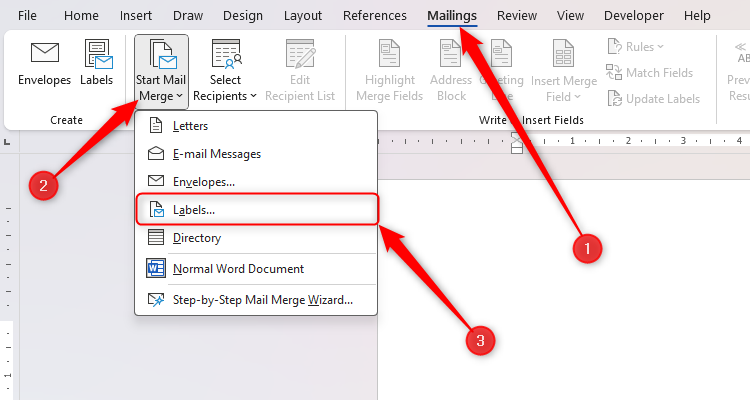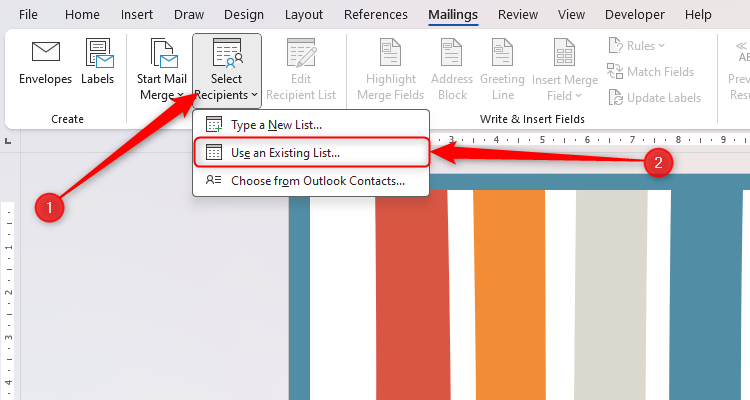Mail Merge Is More Useful Than You Think: 4 Practical Uses
Microsoft Word Mail Merge: Practical Tips for Improved Efficiency
This article will introduce the daily application of Microsoft Word mail merge function, helping you easily handle tasks such as address tags, personalized reports, cover letters and certificates. The mail merge feature allows you to create personalized documents, such as sending personalized emails in batches or creating certificates with personal information. You can create a list of data directly in Word, or import data from programs like Excel. This article will focus on how to use the mail merging feature in combination with Excel. Please note that this feature is currently limited to Microsoft 365 desktop version of Word apps.
1. Make wedding invitations or Christmas greeting card address tags
Writing addresses by hand is time-consuming and labor-intensive and prone to errors. With Word Mail Merge feature, you can easily print address labels or cut and paste them on plain paper.
First, create a name and address list in Excel, with each row of information located in a different column, and the first row is the title. Make sure all cells are filled in, empty cells will affect mail merge.

Save Excel file.
Create a new blank document in Word and click "Mail" > "Start Mail Merge" > "Tag".

Select "30 Tags per Page" to save paper and click "OK".

Enable the "Show/Hide" (¶) option to view the label layout.
Click "Mail"> "Select Recipient"> "Use Existing List", select the Excel file and open it. In the Select Table dialog box, select the "First row contains column titles" check box and click OK.

Click "Insert Merge Domain", select the title in Excel (such as "Name"), press Enter, and then add address information. If the text is out of the label range, you can drag the bottom of the label to resize.

Click "Update Tag" to apply the merge domain.

Click "Preview Results" to check the label effect.

Click "Finish and Merge"> "Print Document" to print the label. To modify a single address, select Edit Single Document.

2. Write a personalized report
This method is suitable for scenarios such as teachers writing student reports.
In a Word document, enter the report subject, use "[name]" instead of the name, and "--" instead of the content that needs to be filled in in person.

In Excel, copy each sentence to the first row and add the "Name" column.

Fill in the content of each report and save the Excel file.
In the Word document, click "Mail" > "Select Recipient" > "Use Existing List", select the Excel file and open it. Select the "First row contains column titles" check box and click "OK".

Select "[Name]" or "--", click "Insert Merge Field" and select the corresponding field.

Click "Preview Results" to view the report, and click "Finish and Merge" to print or edit the report.

3. Write a cover letter
Using the email merge feature, you can quickly create multiple cover letters to highlight different skills.
In Excel, enter the skill category in the first line and enter the corresponding skill description in the second line.

Save Excel file.
In Word, enter the beginning and end of the cover letter. Click "Mail" > "Select Recipient" > "Use Existing List", select the Excel file and open it. Select the "First row contains column titles" check box and click "OK".

Click "Insert Merge Domain" and select the skill description.

Click "Preview Results" to check the cover letter, click "Finish and Merge"> "Edit a Single Document" to modify it.

IV. Design Certificate
Create a list of winner information in Excel and save the file.

Design certificates in Word, you can use templates. Click "Mail" > "Select Recipient" > "Use Existing List", select the Excel file and open it. Select the "First row contains column titles" check box and click "OK".

Click "Insert Merge Domain" to add the information to the certificate.

Click "Preview Results" to check the certificate, click "Finish and Merge"> "Print Document" to print the certificate.

I hope the above information can help you better utilize the Word email merging function and improve your work efficiency!
The above is the detailed content of Mail Merge Is More Useful Than You Think: 4 Practical Uses. For more information, please follow other related articles on the PHP Chinese website!

Hot AI Tools

Undresser.AI Undress
AI-powered app for creating realistic nude photos

AI Clothes Remover
Online AI tool for removing clothes from photos.

Undress AI Tool
Undress images for free

Clothoff.io
AI clothes remover

Video Face Swap
Swap faces in any video effortlessly with our completely free AI face swap tool!

Hot Article

Hot Tools

Notepad++7.3.1
Easy-to-use and free code editor

SublimeText3 Chinese version
Chinese version, very easy to use

Zend Studio 13.0.1
Powerful PHP integrated development environment

Dreamweaver CS6
Visual web development tools

SublimeText3 Mac version
God-level code editing software (SublimeText3)

Hot Topics
 1659
1659
 14
14
 1416
1416
 52
52
 1310
1310
 25
25
 1258
1258
 29
29
 1232
1232
 24
24
 If You Don't Rename Tables in Excel, Today's the Day to Start
Apr 15, 2025 am 12:58 AM
If You Don't Rename Tables in Excel, Today's the Day to Start
Apr 15, 2025 am 12:58 AM
Quick link Why should tables be named in Excel How to name a table in Excel Excel table naming rules and techniques By default, tables in Excel are named Table1, Table2, Table3, and so on. However, you don't have to stick to these tags. In fact, it would be better if you don't! In this quick guide, I will explain why you should always rename tables in Excel and show you how to do this. Why should tables be named in Excel While it may take some time to develop the habit of naming tables in Excel (if you don't usually do this), the following reasons illustrate today
 You Need to Know What the Hash Sign Does in Excel Formulas
Apr 08, 2025 am 12:55 AM
You Need to Know What the Hash Sign Does in Excel Formulas
Apr 08, 2025 am 12:55 AM
Excel Overflow Range Operator (#) enables formulas to be automatically adjusted to accommodate changes in overflow range size. This feature is only available for Microsoft 365 Excel for Windows or Mac. Common functions such as UNIQUE, COUNTIF, and SORTBY can be used in conjunction with overflow range operators to generate dynamic sortable lists. The pound sign (#) in the Excel formula is also called the overflow range operator, which instructs the program to consider all results in the overflow range. Therefore, even if the overflow range increases or decreases, the formula containing # will automatically reflect this change. How to list and sort unique values in Microsoft Excel
 How to Format a Spilled Array in Excel
Apr 10, 2025 pm 12:01 PM
How to Format a Spilled Array in Excel
Apr 10, 2025 pm 12:01 PM
Use formula conditional formatting to handle overflow arrays in Excel Direct formatting of overflow arrays in Excel can cause problems, especially when the data shape or size changes. Formula-based conditional formatting rules allow automatic formatting to be adjusted when data parameters change. Adding a dollar sign ($) before a column reference applies a rule to all rows in the data. In Excel, you can apply direct formatting to the values or background of a cell to make the spreadsheet easier to read. However, when an Excel formula returns a set of values (called overflow arrays), applying direct formatting will cause problems if the size or shape of the data changes. Suppose you have this spreadsheet with overflow results from the PIVOTBY formula,
 How to change Excel table styles and remove table formatting
Apr 19, 2025 am 11:45 AM
How to change Excel table styles and remove table formatting
Apr 19, 2025 am 11:45 AM
This tutorial shows you how to quickly apply, modify, and remove Excel table styles while preserving all table functionalities. Want to make your Excel tables look exactly how you want? Read on! After creating an Excel table, the first step is usual
 Excel MATCH function with formula examples
Apr 15, 2025 am 11:21 AM
Excel MATCH function with formula examples
Apr 15, 2025 am 11:21 AM
This tutorial explains how to use MATCH function in Excel with formula examples. It also shows how to improve your lookup formulas by a making dynamic formula with VLOOKUP and MATCH. In Microsoft Excel, there are many different lookup/ref
 How to Use Excel's AGGREGATE Function to Refine Calculations
Apr 12, 2025 am 12:54 AM
How to Use Excel's AGGREGATE Function to Refine Calculations
Apr 12, 2025 am 12:54 AM
Quick Links The AGGREGATE Syntax
 Excel: Compare strings in two cells for matches (case-insensitive or exact)
Apr 16, 2025 am 11:26 AM
Excel: Compare strings in two cells for matches (case-insensitive or exact)
Apr 16, 2025 am 11:26 AM
The tutorial shows how to compare text strings in Excel for case-insensitive and exact match. You will learn a number of formulas to compare two cells by their values, string length, or the number of occurrences of a specific character, a





